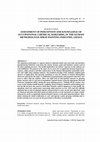Papers by Stephen Osei-Bonsu

Journal of Science and Technology (Ghana), 2011
The hazardous particulates or vapours found in informal small scale auto body and furniture manuf... more The hazardous particulates or vapours found in informal small scale auto body and furniture manufacturing industries come from the solvent, lacquer, paint and hardener systems used in the spray painting processes. The health implications of workers' exposure in this industry are well established. The purpose of the study was to assess the occupational chemical hazards perceptions, safety practices and their enforcement in the Kumasi Metropolitan automobile, furniture and coffin spray painting industry. One hundred and fifty (150) randomly sampled paint sprayers at eighty-three (83) spraying workshops in nine (9) suburbs in Kumasi Metropolitan Area were selected for the study. A combination of questionnaires and purposive interviews were used to collect data for analysis. There was high level of self-reported exposure to spraying fumes, because only 0.7 percent of respondents reported always using the appropriate Personal Protective Equipment (PPE), during the spray painting process. Virtually all the workers were aware of the manifest health hazards; coughing, throat irritation, headache and breathing problem but did not know the extent to which these hazards could be dangerous to their health. Respondents rated Law enforcement concerning safety practices as low; EPA and DFI officials attributed this to lack of adequate logistics and personnel to carry out the task effectively. Lack of Chemical education and enforcement of safety practices in the metropolis are major contributing factors of the occupational chemical hazard exposure in the paint spraying industry. Mandatory training for initial certification to work and operate a paint spraying workshop and refresher training every two years by the government is therefore recommended.

The hazardous particulates or vapours found in informal small scale auto body and furniture manuf... more The hazardous particulates or vapours found in informal small scale auto body and furniture manufacturing industries come from the solvent, lacquer, paint and hardener systems used in the spray painting processes. The health implications of workers' exposure in this industry are well established. The purpose of the study was to assess the occupational chemical hazards perceptions , safety practices and their enforcement in the Kumasi Metropolitan automobile, furniture and coffin spray painting industry. One hundred and fifty (150) randomly sampled paint sprayers at eighty-three (83) spraying workshops in nine (9) suburbs in Kumasi Metropolitan Area were selected for the study. A combination of questionnaires and purposive interviews were used to collect data for analysis. There was high level of self-reported exposure to spraying fumes, because only 0.7 percent of respondents reported always using the appropriate Personal Protective Equipment (PPE), during the spray painting process. Virtually all the workers were aware of the manifest health hazards; coughing, throat irritation, headache and breathing problem but did not know the extent to which these hazards could be dangerous to their health. Respondents rated Law enforcement concerning safety practices as low; EPA and DFI officials attributed this to lack of adequate logistics and personnel to carry out the task effectively. Lack of Chemical education and enforcement of safety practices in the metropolis are major contributing factors of the occupational chemical hazard exposure in the paint spraying industry. Mandatory training for initial certification to work and operate a paint spraying workshop and re-fresher training every two years by the government is therefore recommended.
Teaching Documents by Stephen Osei-Bonsu
Drafts by Stephen Osei-Bonsu
Although a 2019 New American Economy report found that 45% of Fortune 500 companies were founded ... more Although a 2019 New American Economy report found that 45% of Fortune 500 companies were founded by immigrants or by their children, and many major corporations are currently led my BIPOC CEOs (including Google, Microsoft and Walgreens), the barriers that minorities and

Uploads
Papers by Stephen Osei-Bonsu
Teaching Documents by Stephen Osei-Bonsu
Drafts by Stephen Osei-Bonsu